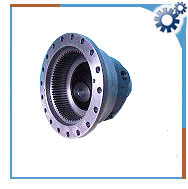
The term epicyclic comes from the path of a point on a planet gear
which traces out an epicycloid in space. Therefore, there are three
elements in the differential.
Epicyclic differential can be simple differential, compound
differential or planetary differential.
- Simple epicyclic differential - consists of a central
external gear meshed with one or more external gear. The planet
gears are meshed with an internal gear that encloses the system.
The planet gears and the planet gear support bearings are held
in a carrier which rotates about the geometric center of the
unit. The ring gear ratio ranges between 2:1 to 11:1.
- Compound epicyclic differential - consists of a
central external gear meshed with one or more external gears.
The sun planet gears are part of two-gear cluster on the same
shaft or axis. The second gear is the ring planet gear, which
are meshed with an internal gear that encloses the system. The
ring gear ratio ranges between 5:1 to 24:1.
- Planetary epicyclic differential - a compact
differential consisting of three elements that are mechanically
connected by the sun and planet gears. The combination of motion
solves many electro-mechanical problems.
|
Epicyclic differential offer high torque capacity and a wide
range of reduction ratios in a compact space. Typical applications of
these differentials include reducers, phase shifting, timing movements,
balance speed and torque, creation of relative speed while running, and
precise speed adjustment.
 The term epicyclic comes from the path of a point on a planet gear
which traces out an epicycloid in space. Therefore, there are three
elements in the differential.
The term epicyclic comes from the path of a point on a planet gear
which traces out an epicycloid in space. Therefore, there are three
elements in the differential.